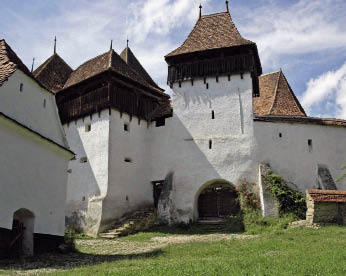Charles Moore on how to renew and maintain life in the deserted villages of rural Romania
To understand this story, one must go back nearly 25 years. As Soviet Communism moved towards collapse in the late 1980s, people were in danger of forgetting Romania. Because of Romania’s relative independence from Moscow, the West played down the insane policies of its despot, Nikolai Ceausescu.
The Spectator, I am glad to say, did not. We sent in journalists under cover, and started a scheme, paid for by kind readers, to send free copies of the magazine, much sought after by print-starved intellectuals. The world finally took notice of Ceausescu’s horrors when he began a policy of systematically destroying all villages, housing peasants in concrete blocks of flats. The Prince of Wales eloquently pleaded for a unique rural culture. Ceausescu was overthrown at Christmas 1989. He had not yet managed to complete his work of destruction. Most of the villages were still standing.
During the dictatorship, no English person did more to help save Romania than Jessica Douglas-Home, artist and widow of Charlie, the editor of the Times. The Mihai Eminescu Trust, which she helped set up, succoured dissidents and writers. The Spectator scheme was a small part of that.
But the fall of Ceausescu created a whole new line of work. One of the most fascinating parts of Romania is the area known as the Siebenburgen, populated since the 12th century by German-speaking people, usually referred to as ‘Saxons’. They developed their own distinctive culture, turning Lutheran among neighbours who were either Orthodox or Catholic, and building astonishing fortified churches, whose curtilage could, in emergency, contain the entire village population, their livestock and supplies.
To this day, these strange buildings, whose wooden-capped look-out towers resemble the studio sets of early German expressionist films, dominate scores of villages in the green, hilly, wooded Transylvanian landscape. Gathered round them are the houses, mainly 19th-century, and all of a pattern. These stand at right angles to the wide streets, which are divided by streams and frequented by geese and wandering livestock. Their thin ends, prettily stuccoed and coloured, look out at one another beneath hipped roofs. The main bulk of each house stretches back from the street, containing cellars, byres and outhouses as well as living quarters. People sleep in beds like chests of drawers, which slide shut during the day.
Behind the houses are wooden barns, and then vegetable gardens and orchards. The edge of the village, at which each plot ends, is often marked by walnut trees, planted because their leaves are supposed to deter flies. Beyond lie deciduous forests and unfenced pastures. Shepherds and cowherds still sleep out there, protecting themselves from the weather in wooden boxes with lids. Although the life is absolutely rural, its atmosphere, as befits the German influence, is more bourgeois than peasant — one of good order, personal pride and craftsmanship, no great lords and no serfs.
But when the ‘grim stability’ of the Ceausescu era ended, people wanted their freedom. The German Chancellor, Helmut Kohl, offered everyone of German blood a place in the fatherland. Most of the Saxons, longing to escape poverty, took it up. And so the villages they had built began to be deserted and increasingly occupied by the large population of Romanian gypsies. Economic recovery was wobbly. State corruption did not go away with the fall of Communism.
As the outside world began to intrude, a problem arose familiar in all cultures that cease to be isolated. People visit them because they love places ‘where time has stood still’, but the actual inhabitants long for greater opportunity, more money, electricity and good drains. The rich Westerner’s proposition, ‘Oh, you mustn’t change anything’, is unappealing. The simple life we romanticise is often unbearably complicated.
So the question of how to ‘save’ such villages is a difficult one. Jessica Douglas-Home and her Trust set out to answer it. Mending the leaking roof of an ancient church would achieve little if no one local cared for the building or knew how to do the work. People trapped by the poverty of the past wanted to throw away anything that reminded them of it. Out went traditional window frames and gates. In came concrete, aluminium and plastic, brash factory-made tiles and garish bricks. A proposal for an ugly Dracula Theme Park (though Dracula had nothing to do with the area) was the clearest example of how everything could go wrong.
The Trust’s leaders realised they would fight a losing battle unless they could turn the scorned old ways to advantage. It struck Jessica that the greatest fascination of these villages lies not in any one object, but in their integrity, their ‘balance’, the harmony between domestic architecture, agriculture, churches and landscape. The whole was more than the sum of the parts. The answer, then, was ‘the Whole Village Project’. It is an idea whose time is coming. Note what Prince Charles plans to do round Dumfries House, the gem in slump-stricken Ayrshire he has rescued.
The hope is that the villagers come to see their past as their future. Their livelihood will increasingly come from well-managed tourism. So rugs are once more being made on local looms, the apple juice is being marketed, the building skills revived. On the edge of the village of Viscri, arguably the most perfect of them all, is a newly built kiln where gypsies have learnt to fire the tiles and bricks needed for the houses to be restored. In Malancrav, the Trust has rebuilt a 19th-century hunting lodge, turning it from a wreck into an elegant, large-roomed house with a library, which people can rent for holidays. In the forest of Breite, on a plateau above Sighisoara, the Trust has employed rangers to look after the great oaks and control the grazing.
The Trust should not be a surrogate welfare state. The Whole Village Project can only work with whole village involvement. In this, the Trust has been lucky in finding an energetic and charismatic Saxon woman called Caroline Fernolend (her German name means ‘faraway land’), from Viscri. She is more than capable of running the work in-country: the Trust aims to remove the need for a London office at all. The need for Western money, though, remains. The Trust spends some $500,000 a year.
In every village helped by the Trust, you can see its work in so many details — the little baskets hanging from trees that are part of the new refuse collection (rubbish was previously hurled into the local ditches), the use of woven, living willow sticks, rather than concrete, to retain the banks of the streams that run through each village, the dancing circles, the houses and the churches restored. The land that time forgot has become the land which time now tends.
For more information: tel 01285 750 624 or www.mihaieminescutrust.org







Comments